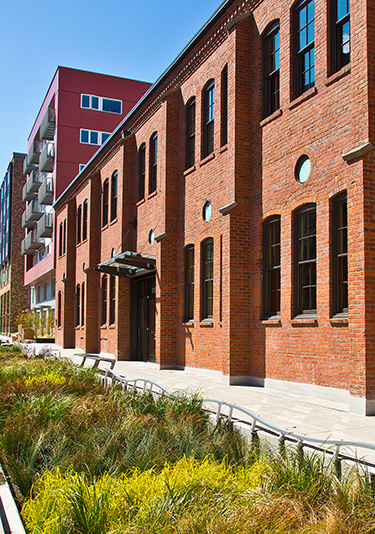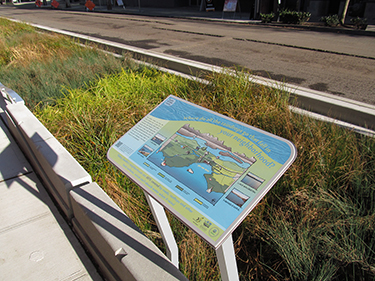|
Subscribe / Renew |
|
|
Contact Us |
|
| ► Subscribe to our Free Weekly Newsletter | |
| home | Welcome, sign in or click here to subscribe. | login |
Environment
| |
 |
March 24, 2016
South Lake Union’s ‘swale on Yale' is getting set to grow
By DAVID SCHWARTZ
KPFF Consulting Engineers
JASON SHARPLEY
Seattle Public Utilities
& BRANDON MORGAN
Vulcan Real Estate
The “swale on Yale” gathers and cleans stormwater runoff from Capitol Hill before it enters Lake Union.
This voluntary retrofit of a storm system in a dense urban setting is the first of its kind in the United States.
The swales — there are two, actually — were a collaboration between Vulcan and Seattle Public Utilities. KPFF Consulting Engineers completed the civil design, and KPG was responsible for the landscape, urban design and interpretive signage.
The swales were built adjacent to the Stack House and Supply Laundry mixed-use complex in South Lake Union. They run along Yale and Pontius avenues between Harrison and Republican streets.
The first two swales went online in 2015. A second set of two will be built concurrently with a new Vulcan development a block to the south. The project is anticipated to finish in 2018.
The swales provide water-quality enhancement for a previously untreated, 435-acre sub-catchment of urban runoff from the 630-acre Capitol Hill area. Stormwater runoff from the streets of upper Capitol Hill transport silts, oils, heavy metals and other pollutants from the streets to the stormwater collection system and into Lake Union.
The swales are significantly improving the water quality by removing a large portion of sediments and other pollutants, improving the long-term environmental health of the lake.
This project will treat over 190 million gallons of stormwater runoff annually once it’s completed.
How the system works
The swales were designed to divert low flows out of the current storm drainage system into the treatment system, which includes a “swirl separator” and the swales. The swirl separator removes large sediments and “floatables.”
The project starts with a flow-diversion structure that backs stormwater up using a weir to divert water towards the treatment system. Higher flows during storm events will overflow the weir and continue down the existing 72-inch piped conveyance system. The diverted lower flows pass through the swirl separator prior to continuing to the swales.
Flow-splitting devices are used to divide the flows from the swirl separator into the four individual swales (including two that are yet to be built). Each of the flow-splitting structures has an emergency overflow to prevent excessive amounts of water from flowing into the swale and to allow for system maintenance.
The peak flow that the swales are initially intended to treat is roughly 3,240 gallons per minute. The swales vary in width and length. The flow splitters are designed to divide the water so that each swale slows the water, retaining it for a minimum of nine minutes.
The swales are designed so that the water entering the swale wells up out of a trench drain to ensure that the flows are spread across the width of the swales. There are also interim weirs to make sure the flows stay spread across the entire width and do not create short circuits.
The weirs also allow the swales to maintain a slope that will keep flow velocities low. Sedges and rushes are densely planted in the swales in order to have a thick area of vegetation to slow and filter the water.
Water quantity and quality monitoring was installed at the upstream and downstream ends of the swale, on Yale between Harrison and Republican, to monitor the water quantity treated and water quality improvements.
The swales were designed as a flow-through system and incorporated rain garden soils and an under drain to allow infiltration to occur and enhance the water treatment capacity of the system.
Public-private partnership
The project was developed and funded as a public-private partnership between Seattle Public Utilities and Vulcan Real Estate. This partnership was critical to the success of the overall project.
Vulcan has provided technical and professional services and will fund approximately $1.3 million of the design and construction costs and provide an easement to the city along the front of their development.
The easement provided sufficient space to construct the swales and still have adequate pedestrian walkways. Without Vulcan’s contribution and its support of the project’s mission, the swales would not have been possible.
What’s next
The first phase of the project is complete, and the second phase is under design, with an estimated design completion date of fall 2016.
Seattle Public Utilities completed the diversion structure, swirl separator, conveyance piping and flow splitters under a city contract.
The revised design for the second phase includes planting the plants “bare-root.” One of the lessons learned from previous planting is that obtaining the plants as bare-root stock is the best way to ensure adequate plant availability. The plantings will be done at similar spacing.
Another design adjustment will be to raise the inflow grate to allow for free flow into the swales, without the grate impeding the flow. Because the swales are performing so well, Seattle Public Utilities is considering increasing the flow to each swale by 30 percent, providing for treatment of roughly 4,200 gallons per minute at peak flow.
David Schwartz is a principal at KPFF Consulting Engineers. Brandon Morgan is a senior development manager at Vulcan Real Estate, and Jason Sharpley is a project manager at Seattle Public Utilities.
Other Stories:
- Big-box store gets a second life after a green makeover
- ‘Passive house’ design can make housing more affordable
- Weyerhaeuser’s new headquarters will show off its wood products
- Developers who try to go green find money stands in their way
- Building operators add energy management to their repertoire
- Ballard fire station goes from energy hog to energy heaven
- What is embodied carbon and why should we care?
- How sharing sit-stand desks will help Antioch be smaller and greener




